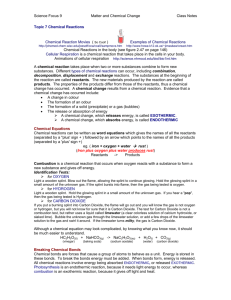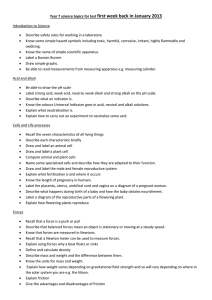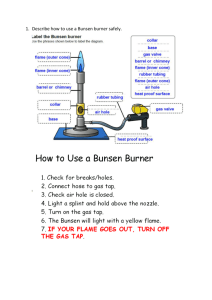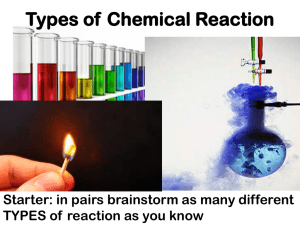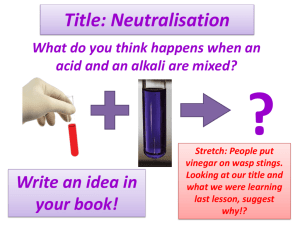Cells & Reproduction Key Notes
advertisement
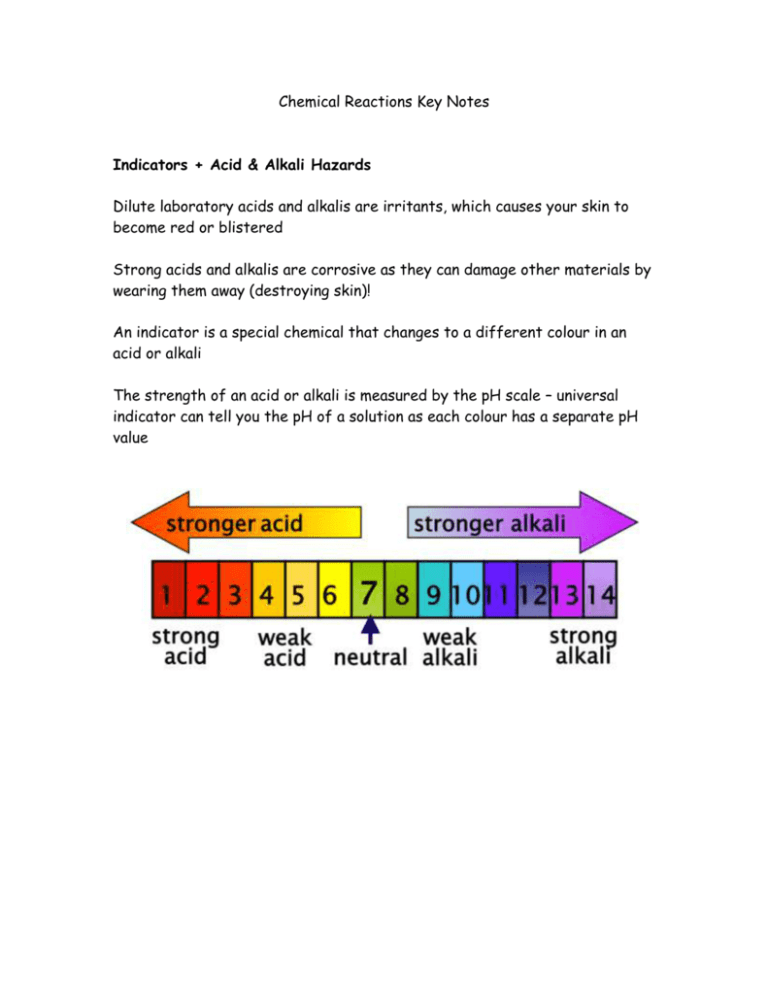
Chemical Reactions Key Notes Indicators + Acid & Alkali Hazards Dilute laboratory acids and alkalis are irritants, which causes your skin to become red or blistered Strong acids and alkalis are corrosive as they can damage other materials by wearing them away (destroying skin)! An indicator is a special chemical that changes to a different colour in an acid or alkali The strength of an acid or alkali is measured by the pH scale – universal indicator can tell you the pH of a solution as each colour has a separate pH value Hazard symbols are used on bottles (and vehicles) that contain hazardous chemicals – they can be identified by anyone, regardless of language Neutralisation The chemical reaction between an acid and alkali is called neutralisation If you add just the right amount of acid and alkali together a neutral solution is formed (the pH value gets close to pH 7 - neutral) Acid + Alkali Salt + Water E.g. a bee sting is acidic, and can be neutralised with just the right amount of the alkali bicarbonate of soda A wasp sting is alkaline, and can be neutralised with just the right amount of the acid vinegar Chemical & Physical Changes Chemical reactions happen anywhere that new substances are made There are usually some obvious changes during a chemical reaction, including A change in colour A gas coming off (you may see fizzing or bubbling) A change in temperature (the reaction mixture may get hotter) A solid may be formed when two solutions are mixed together Ice melting into water is an example of a physical change - no new substances are formed during physical changes Acid + Metal (Including H2 Test) Many metals react with acids – producing the gas hydrogen A burning splint is the test for this, producing a squeaky pop when it ignites There are 3 tests we can do to find out what gas it is: If it is carbon dioxide it will put out a lit splint / turn limewater cloudy when it is bubbled through If it is oxygen, it will relight a glowing splint If it is hydrogen, it will ignite with a squeaky pop Acid + Carbonates (Including CO2 Test) When a metal carbonate reacts with acid, it fizzes and seems to disappear The carbonate and the acid have reacted, producing a salt, water and carbon dioxide Metal carbonate + acid salt + water + carbon dioxide There are 3 tests we can do to find out what gas it is: If it is carbon dioxide it will put out a lit splint / turn limewater cloudy when it is bubbled through If it is oxygen, it will relight a glowing splint If it is hydrogen, it will ignite with a squeaky pop Combustion Combustion is the scientific name for burning Combustion is the reaction when a substance burns and reacts with oxygen, producing heat and light energy Combustion results in the formation of both carbon dioxide & water When substances burn, reacting with oxygen, the new products formed are called oxides Methane + Oxygen → Carbon Dioxide + Water For a fire to take place there are three essential components: Heat Oxygen Fuel Explosives & Rusting When a chemical releases a large amount of energy very quickly an explosion occurs An explosion is a chemical reaction, which causes huge amounts of gas to form as well as releasing a lot of heat The chemical reactions need oxygen to take place: If the reaction needs oxygen from the air it is a combustion reaction If the reaction does not need additional oxygen from the air it is a decomposition reaction Rusting occurs when iron or steel is in contact with both water and oxygen Rusting is a chemical reaction, which produced the reddish-brown iron oxide We can prevent rusting by removing one of the requirements – i.e. remove the water from contacting the iron (by painting it)


